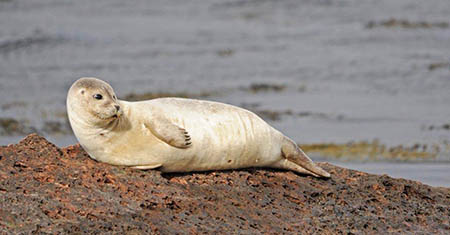

The Riches of Amat
The riches of Amat are not very portable. They are the age old trees, forest colours through the season, the rivers, the hills, the heather, the garden and all the stirring memories of the Clan Chief leading out his men in the Hannoverian cause, his lady hiding the eldest son, a wounded Jacobite, under the floorboards. And a family crest on the sifting room ceiling which directly re-calls Robert the Bruce, saved from the English by hiding him in a hay cart and forking the hay over his recumbent body.

Forest Walk
There is plenty of wildlife. Not so long ago the pine Martens nested in the house. That was before Pepsina, star of Captain Corelli’s Mandolin came on the bookstalls or I might have taken a different attitude. “How the hell do I rid myself of these rodents behind the oak panelling”
I hollered, knowing they are a protected species. “Try music” opined the government agency man. I mean honestly, what do I pay my taxes for?
Amat is a community and always has been. There used to be a church here, a trading store and a post office. In the 1940’s there was the Amat dance band and, 60 years on, the leader Willy Macdonald, who was my crofting neighbour, continued to play his fiddle for local ceilidhs — how’s that for continuity? Despite the drift away from the glen, there are still a dozen houses lived in and several more let for holidays. The cowbyre we have converted into a community hall. There are 7 bridges over the water between here and the impressive Glencalvie Falls, all but 2 privately built, which help us to get about and provide wonderful walking.
I spent formative years in Argyll. I remember the Sunderland flying boats taking off from the bay at Oban festooned with depth charges, presents for the U boats whose commanders called them “Porcupines”. My personal contribution to the war effort was limited to boosting morale by painting swastikas on the loo paper. I love going back but consider myself fortunate to live at Amat, the watershed hills to the South West ensure we do not get so much rain yet enough, with its mix of peat and sandy soil, to provide wonderful growing conditions for shrubs.

Sunderland Flying Boat
The greater the amount and diversity of ground cover, the wider the range of wild flowers, birds, insects and beasties. In themselves these provide huge enjoyment to visitors but also, the ground cover helps the productivity of the river. Up to 50% of juvenile fish feed can come from the bank in the form of insects and leaf mould leading to greater fish densities.
Did you know that greater ground cover levels can save life? Man has given himself global warming with increased weather volatility in winter, that’s official. A direct consequence is the ever more prevalent propensity for rivers to flood. Just imagine tarmacing and draining the whole glen and the subsequent ferocity of spate water from a sudden thaw of winter snows.
The way to minimise the danger is to increase the levels of ground cover, especially on the steeper slopes. You then create a gigantic sponge and a hydraulic regime ensuring river levels rise slower, more consistently and never reach such destructive heights. By increasing ground cover, restoring native pinewoods, blocking up man made drainage channels we buy ourselves time and safety.
We also help the wild salmon and his predators the seals the ospreys and other fish eating birds for, very fierce flow levels, wash out the salmon breeding grounds destroying the stocks.

Young Seal
Photo by: Sander Macdonald
We have culled back the seals' predator in nature and protected many species that feed on salmon. The very survival of wild salmon and jobs on east coast Highland rivers may now depend on disease spreading through overcrowded seal populations. At Amat we work to stabilise the river boundary with trees and let the vegetation levels increase wherever we can. The right bank of the Carron was bought at the dawn of the 20th century. Having both banks and so many bridges affords great management flexibility to stabilise banks on the outside of the bends where hydraulic forces are greatest whilst allowing anglers to fish on the opposite side.
The anglers are wonderful. They put back most of the fish caught and are adept at carefully handling the spawners. I derive considerable enjoyment in watching these fish cutting their redds here in the Autumn. But we have had to reduce rod numbers and fishing hours to help the dwindling stocks. The wild salmon is now an endangered species.
All in the Highlands need to speak up for a healthy sustainable sport fishing industry, or jobs will be lost as anglers are increasingly attracted away to places like Russia where sport is nowadays accessible and rewarding. The message is clear, one cannot fiddle about. To manage Nature, the plan must embrace the complete food chain and a balance struck between exploitation by predators on the one hand and spawning stock and in river conditions on the other. The problems of minimising risks to life and ensuring a healthy and sustainable sport fish industry have much in common. Getting that message over is a current fad of mine and I apologise for warbling on.

Amat in 1876
I’m often asked “When was Amat house built?” Amat is a Norse word suggesting that the Vikings came here. There will have been something which has metamorphosed with time over a considerable period. The invention of the camera revealed the Ross house to be a long low building with dormer windows above the ground floor. In Edwardian times one end was built up and a tower added by a diamond merchant from South Africa. Then in the 1920’s the increased height was extended over the length of the house by the Conygham family and I have added a plant house /conservatory on one end to let us watch the river in comfort surrounded by tender shrubs.

Amat Lodge in 1890s
I remember a friend telling me that he’d overheard a cross dad upbraiding his son with the words “When in Rome young man I expect you to do as the Romainians do”. The natural charm of Amat seems to positively invite visitors to respect the place and leave with a desire to come back and find it as they remember it. I never find it necessary to scold anyone and long may the natural beauty of the place be its best attraction and security.
LEGAL INFORMATION
The information and material on this site is provided in good faith for general information only and no part shall form any part of a contract. Amat Estate and its agents assume no responsibility for the accuracy of any particular statement and accept no liability for any loss or damage which may arise from reliance upon the information contained on this website. Links to other websites from these pages are for general information only and Amat Estate and its agents accept no responsibility or liability for access to other material on any website which is linked from or to this website.
© 2021 amatsalmon.com